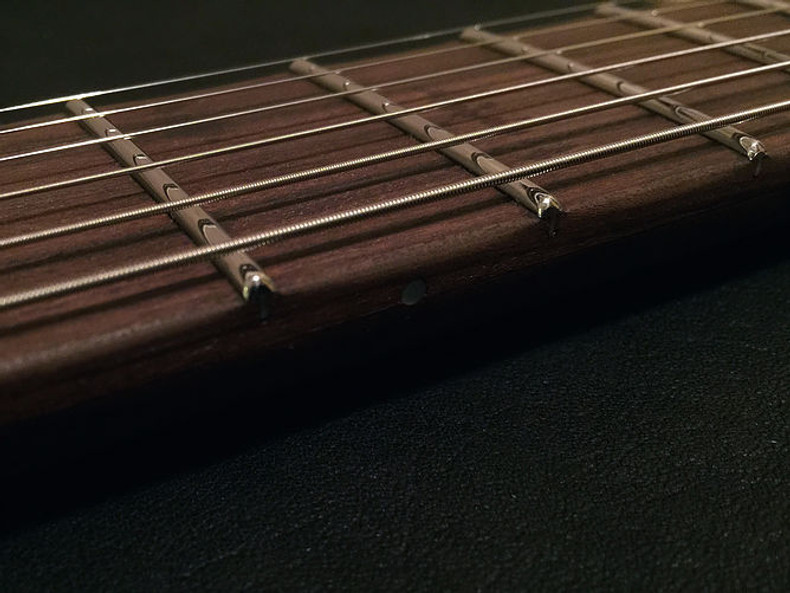Originally posted Aug. 8, 2016
For the last 60+ years, electric guitar manufacturers have used, for the most part, a type of alloy known as nickel, or "German" silver. This alloy is composed of copper, nickel and zinc. Notice it contains no silver. It got the name because of the silvery hue imparted by the nickel. The most common type used in guitar frets is known as 18% nickel silver, so-called because the alloy consists of 18% nickel, with the majority being copper. This is the classic alloy we've known on most guitars for the better part of the last century.

In the early 1990s, luthier Ken Parker introduced a new guitar design he called "The Fly". This instrument contained multiple technological innovations and was one of a very small number of guitars to see a significant level of commercial success while departing dramatically from the first electric guitars built in the '50s. One of those innovations was the use of a new fret material: stainless steel. The frets on The Fly were not like traditional fretwire, which is installed with a "tang" driven into a slotted fingerboard, while the "crown" rests on top of the fingerboard surface. Parker's frets were half-circles, glued onto the surface of a thin carbon glass-epoxy fingerboard. Quite a departure from normal construction methods, but integral to the Fly's unique design. Parker's reason for using stainless steel frets was profound, and his explanation made a tremendous amount of sense to this author. Paraphrasing, he pointed out that nickel silver frets wear with use. So while guitar builders go to great pains to ensure their instruments play perfectly right out of the case, they do not tend to stay that way for very long. Frets compress and deform from friction with strings, developing flat spots and divots, ultimately changing the shape of the crown that is so important to proper intonation and low action without string rattles and buzzes. He reasoned that a harder fret material would ensure his fret crown remained as he intended for practically the life of the guitar. And so far, 20+ years later, that seems to be the case.
Fast forward to 2002. Another extremely talented luthier from California named Tom Anderson pioneered the use of a type of stainless steel fret wire that was extruded and installed in the same way as old-school nickel silver frets. This allowed traditional slotted fingerboards to be retrofitted with a new stainless steel alloy. It also allowed Tom and his company to begin manufacturing all of his guitars with this wire. Parts manufacturer Warmoth followed soon, as did other high-end boutique manufacturers. Independent builders and techs began to see the demand and find out some of the idiosyncrasies of this fret material, namely its difficulty to handle and install, along with excessive wear on standard fretting tools (and often the hands wielding them).
What we've witnessed in certain circles over the last 10-15 years is the introduction of a whole new guitar component over which to argue the merits. Move over maple vs. rosewood argument: We now have to talk about nickel silver vs. stainless steel frets!

Fret Material Pros and Cons
Nickel Silver Pros: As mentioned above, nickel silver is the traditional wire used on the beloved classic electric guitars made in the '50s and '60s. Guitar players tend to be funny creatures. We value uniqueness, yet seem to instinctively reject anything that strays from our familiar comfort zones - our favorite songs, our favorite players, our favorite tones. Whatever they used, must be what we should use to make those sounds, right? Just make sure you have your own style, too. A bit of a conundrum, it seems. As this type of wire was suitable for all the classic sounds created by all the guitar heroes, it makes sense to use the same thing for emulating those sounds created by those players. It is a fairly soft metal, easy to bend, shape, file and polish. It is the most popular fret wire by far (it's all most manufacturers use). It has a familiar feel, and there are plenty of players who insist it sounds "warmer" than stainless steel.
Nickel Silver Cons: As it is a softer material, it is subject to wear and deformation over time. It is also subject to oxidation and corrosion from moisture in the environment, oils, dirt and acid from contact with human skin as well as a metallurgical reaction (called galling) with strings. The reaction can cause your strings to turn black and your frets to turn green. This in turn causes a gritty, rough feel that can take all the fun out of playing an otherwise stellar instrument. To maintain a freshly polished, smooth feel for fast playing and bends without a gritty or sticky feeling, nickel silver frets often require regular treatment with abrasives or chemicals. Traditionally, 0000 steel wool and Gorgomyte are two common treatments to remove oxidation and polish frets. As frets wear and compress, flat spots and divots appear. This can affect intonation and cause uneven frets, resulting in sub-optimal string action or annoying fret rattles and buzzes. A trip to the tech is often required. A procedure known as a fret level or "grind and polish" is done, which is not a job for amateurs. This maintenance can be costly, and ultimately nickel silver frets will require replacement once there is no longer enough material to level and crown. Expect to spend at least $300 on a quality fret replacement job.
Stainless Steel Pros: Impervious to oxidation and corrosion, stainless steel fret wire NEVER requires polishing! When you get a new guitar with stainless steels frets, the mirror shine and smooth-as-glass surface will remain for years, if not the life of the guitar. The fret crowns remain as the builder intended, without wearing or flattening and without reacting to standard electric guitar strings. Effortless bends with zero friction and extra-long string life are the result, and its something that is often overlooked in the types of discussions in favor of the durability afforded by the superior hardness.
Stainless Steel Cons: Stainless steel frets are hard. They are hard to bend, hard to file, hard to polish. This makes it more expensive for manufacturers and luthiers/techs to install. Expect an upcharge for stainless steel frets. This is the result of increased labor as well as factoring in increased wear and tear on shop tools. Some players have found that in comparison to traditional nickel silver frets, stainless steel frets have a brighter attack. This is an open debate with strong opinions cast in both directions - either there is a noticeable and detrimental affect on the tone, or there is no noticeable difference. Still others do claim to find a difference and prefer it to nickel silver. One theory we find to be of interest is that there are multiple manufacturers of stainless steel fret wire, all using a slightly different alloy. Most high-end builders today use a German-made fret wire from the brand Jescar, and it is without a doubt exceptional. Jescar makes both types of fret wire, and is highly recommended regardless of the metal you choose.
Bottom Line:
If you have never experienced stainless steel fret wire, you should probably try to get your hands on a guitar with some installed and see what you think. If asked my opinion, I will tell anyone who wants to know that I will not own a guitar without stainless steel frets, for my personal use. Anything I do get that is going to remain in my personal collection will end up getting refretted with stainless steel frets. The reasons are mentioned above, but to summarize: They never oxidize or corrode, and my strings last considerably longer when used with stainless wire. Smoothly polished frets result in practically no friction, no resistance when sliding or bending, and the intonation and playing surface remains as intended, indefinitely. No more polishing, leveling or refretting. I make fewer string changes and experience no detrimental impact on my tone (subjective, of course). Nickel silver frets are yesterday. Stainless steel frets are tomorrow. If you have any questions or comments about frets, or anything else related to guitars, send me an email at jon@killerburstguitars.com. I'd love to hear from you.
2020 EDIT:
Since this article was originally written, some popular string companies have started manufacturing strings using different alloys than the traditional nickel (or nickel plating) for the wound strings. Some have reported that the new string types can be more aggressive, with signs of wear appearing even on stainless frets. This author's personal opinions and observations have been formed using "old school" nickel plated wound strings.
2022 EDIT:
In a recent discussion with an industry colleague it was brought to my attention that some players can find the effortless, slippery feel of stainless steel frets to be a detriment to their playing style. It's a worthwhile point to consider.

